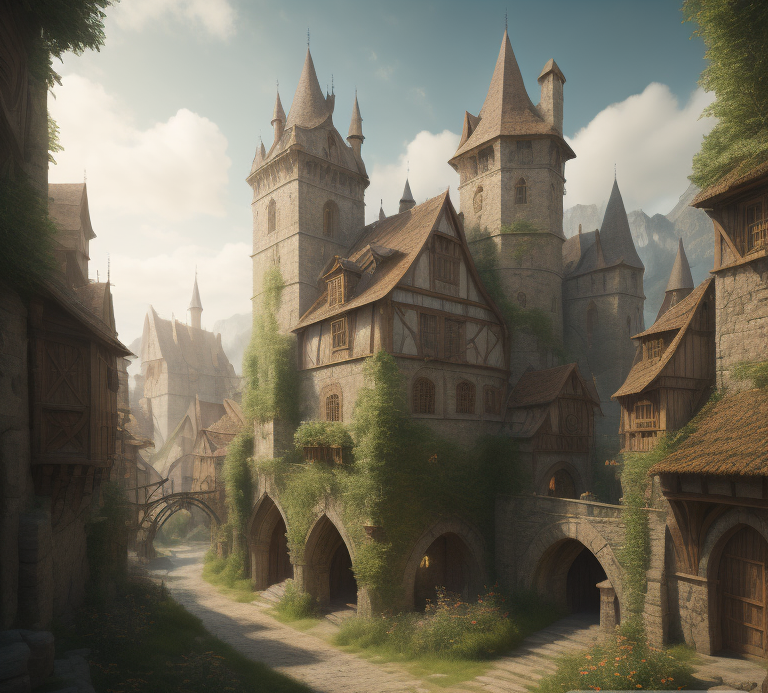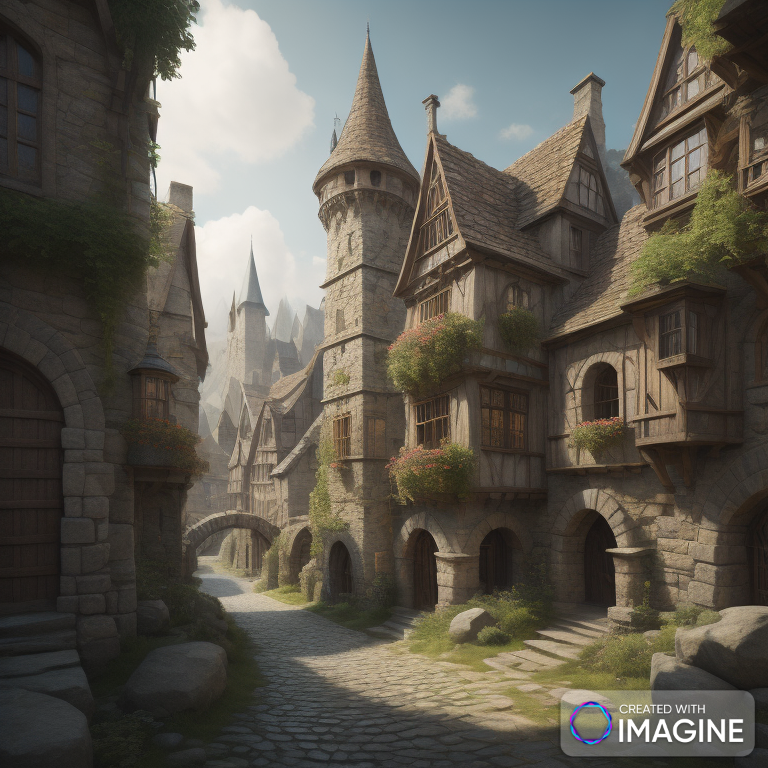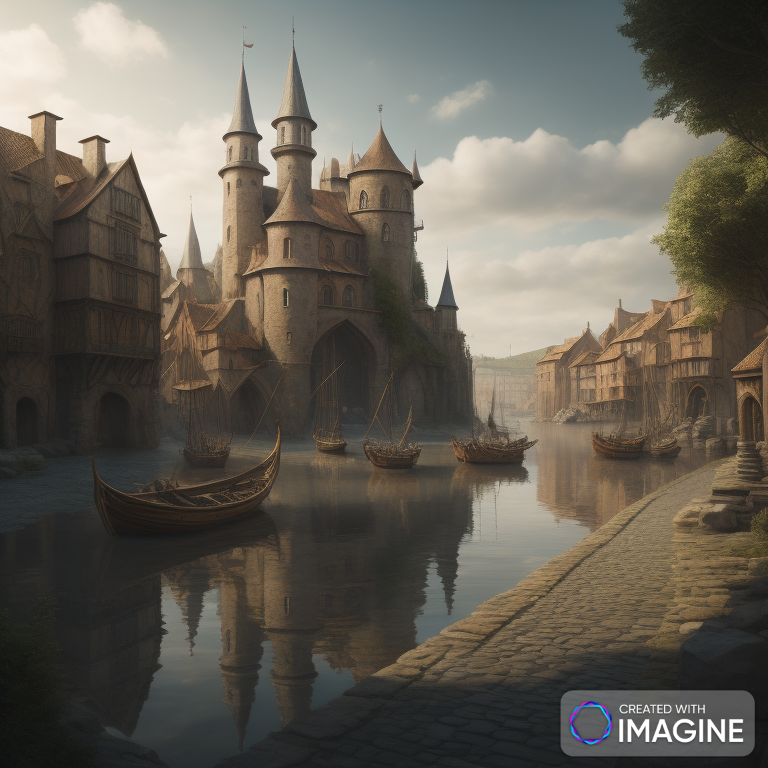Midaria
view of the streets in Midaria
Founded more than a thousand years ago, by the legendary ruling couple of Erior and his wife Dawré, Midaria is the capital city of the Empire of Wisterand, and of the Great Kingdom of Midaria. It is also the largest city in all of Ered. It is a place of knowledge and culture, as much as a place off power.
It's the most cosmopolitan city within the empire, and though the majority of the inhabitants are the Sierian people, you can find a large community of all the ethnicities within the empire, and even from outside.
View of the streets in Midaria
Demographics
The city of Midaria is the largest city in all of Ered, with approximately 750000 inhabitants. The city is around 95km² so the density is about 7900/km², which makes it also the most densely populated city in the world. (note: this doesn't include the port of Puer)
People are mostely of Sierian heritage: around 60% of the population. The other most represented ethnicity is the Mermemkh people with about 15% of the inner walls population, then the
Oranian people with about 10% of the population, then Valean people represent around 5%. The remaining 5% is devided between people from almost all around the world, and not only from the empire. in short, it is the most cosmopolitant city as well. All these diasporas shaped the city and it is not uncommon to see Daminian temples (religion of the Mermekh people), or a bilingual sign above a shop or a pub.
Government
the Great Kingdom of Midaria and with it The Empire of Wisterand being a centralised power, everything happens in Midaria. Midaria is under the direct control of the Great King.
The Provost of the Merchants:
Practicaly though the governance of the city is delegated to the Provost of the Merchants, whose responsabilities include supplying the city, public works, the tax base and jurisdiction over river trade (even though the city is not directly built on the river). He is somehow the equivalent to what a mayor is in our world. He is elected every four years by representatives of the factions within the city.
Every faction in the city has a representative who’s able to vote or run for the election: bakers, merchants, goldsmiths, blacksmiths, tanners… there are fifteen of them. The election is a majority vote.
Defences
Midaria is a very well defended city, a very large wall surounds it, about twenty feet of width, with watchtowers every two hundred feet or so. The city is protecetd also by two citadels, huge forteresses, one to the North-West of the city, the other, the bigger one to the South, they would serve in case of an attack and the poeple could secure themselves within their walls. In addition to that, there is "the shelter" and its park, in the very center of the city. This would be used as the royal refuge.
Industry & Trade
Tanning indusstry is probably the most prevalent within Midaria and this craft is recognised around the empire and beyond. The leather is produced by the cattle, sheep and goat farming around the city, and is then exported everywhere.
Second most important industry would be armour and wapon crafting, Midarian swords are renouned in all Ered.
Infrastructure
Sierian culture revolves around the respect of the four elements: light, gas, water and dust (fire, air, water and earth). Therefor the all take a part in the infrastuctures within the city: there are a lot of parcs, fountains and pools and baths are found all around the city, streets are lit by torchs even by daylight, and there are large squares and streets are usually wide...
Midaria is very well built with a running clear water, as well as a sewage system for grey and brown water. Grey and brown water are used in the different parcs and fields within the city, therefor the river is not polluted, not even by the tanning industry which is important.
View of the canal between Midaria and the port of Puer.
Guilds and Factions
There are several official factions within Midaria, in fact, every profession is a faction: backers, tanners, fishermen, market gardeners and farmers, merchants, textile manufacturers and dyers, goldsmiths, jewellers, blacksmiths, armourers, builders, stoneworkers, woodworkers, bankers and solicitors. Those factions have a real political role as they’re the ones who vote for the Provost. First they each designate a representative, then they elect the Provost amongst those fifteen candidates.
There’re also less official, or criminal guilds of thieves, pickpockets, assassins, smugglers… anything can be found and paid for in Midaria
Architecture
Sierian architecture is very simple, austere even. There are no ornaments, no carvings, no relief on the facades. Building are made from wood and stone. Light pours from the outside in though thanks to large opening and windows in semicircular arch or ribbed cross (depending of the period).
Oftentimes weeds are left growing on them, which can make it seem people don't look after their monuments. But Sierian people are close to nature, and see any kind of living being as valuable and worth keeping.
Geography
Midaria is a vast and modern city, built around two small mounts, on the northern bank of the Greflu, the biggest river within the subcontinent. Its location is pretty central on the subcontinent of Wisterand: its very name is an indication of this as in Wistlirien Midaria literally means "village of the middle, about a thousand miles South of the high range of the Ramparts Mountains, a couple miles South-West of the very large forest called the Forest of the Forsaken Souls and some two hundred miles away of the frontiere of the Baran Kingdom to the East.
Climate
The climate is close to what we would refer to as a Maditerranean climate, with mildly cold winters and hot dry summers. The high mountain ranges not far to the North, the river to the South and the East, and the large and dense forest to the North-West, put the city under the influence of winds from the South-West, which bring rain during the wet seasons of autumn and winter.
Natural Resources
Spelt, barley, and oat, from the fields around and within the city (one of the specificities of Sierian cities is that they have fields within their walls), vegetables and fruits such as apples, pairs, all sorts of squashes, leaks, cabages... Siérian people breed sheeps, goats and cows to produce milk, cheese, meet and leather, fish from the Greflu, even though the city is not directly constructed on the river, the port of Puer is close enough to provide fish to the city, thanks to the canal built to link the city to the river. Wood comes from the forest not far to the North-West.
Founding Date
1MEE
Alternative Name(s)
Midaria the Great, The city of the Markis, Mida
Type
Capital
Population
750000 approximately
Related Ethnicities
Inhabitant Demonym
Midarian
Location under
the Great Kingdom of Midaria
Included Locations
Owner/Ruler
Ruling/Owning Rank
Owning Organization
Characters in Location





Comments